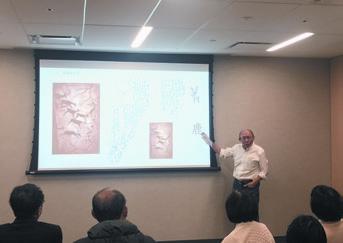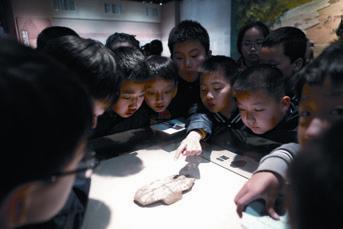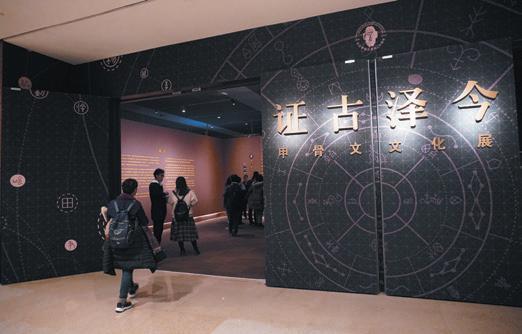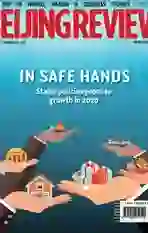Written in Memory
2019-12-27BySudeshnaSarkar,JiJing&LiQing
By Sudeshna Sarkar, Ji Jing & Li Qing

As a supervisor at the United Nations Chinese language program in New York, Yong Ho received a letter almost 15 years ago that set in motion an initiative that has become a cultural legacy.
It was from a professor at Henan University and an expert on Chinese ancient writing, Wang Yunzhi. Wang was looking for funds to establish a museum of Chinese writing in Anyang, Henan Province in central China. The city has a niche in history as the site of Yin, the ancient capital of the Shang Dynasty (about 1600-1024 B.C.), and boasts a far-reaching influence still felt today—the oracle bone inscription (OBI) legacy.
“He spoke to me about his idea to start a museum,” Ho said. “He asked if I could help him raise funds in the United States.”
Wang also approached Henan authorities, who provided land and funding for the museum. In 2009, the National Museum of Chinese Writing opened in Anyang to facilitate research on the OBI.
History on bones
Diviners at the Shang court used heated cattle bones and turtle shells to make predictions. The subjects were diverse, ranging from the weather and war to the reason for the kings toothache. The answers were interpreted from the cracks that appeared on the heated bones.Millenniums later, thousands of unearthed jiaguwen, or the OBI, provide indisputable records about the dynasty and its kingdom since the diviners also inscribed the questions and their interpretations on the bones.


“The discovery enabled us to pinpoint the origin of the Chinese script and authenticate the beginning of Chinese written history as dating back to the Shang Dynasty. There are four major ancient writing systems in the world and the Chinese script is the only one that remains in use,” Ho said.
The other three are the Egyptian script, the Sumerian script that prevailed in the Middle East and the Mayan in Mesoamerica. Only Chinese writing has remained logographic, a characterbased rather than alphabet-based system, and survived. The OBI therefore has a crucial role in both the comparative study of civilizations and the origin of writing.
The earliest bones were found by villagers who did not know what they were and sold them to apothecaries, who touted them as“dragon bones” with medicinal properties. The first to recognize the markings on the bones as some form of ancient script and realize their value as historical artifacts was Wang Yirong, Chancellor of the Imperial Academy of the Qing Dynasty (1644-1911). Thus, 1899 is regarded as the official discovery year of the relics.
In 2016, with just three years left before the 120th anniversary of the formal discovery of the bones, research on them took on a sense of urgency. The Anyang museum announced awards ranging from 50,000-100,000 yuan($7,140-14,290) to spur research, especially deciphering the characters inscribed on the bones.
At a symposium on philosophy and social science on May 17, 2016, President Xi Jinping said some subjects concern the inheritance of culture, such as research on ancient characters like the OBI. It is important to ensure the research is continued and its results are passed on.
While over 150,000 pieces of oracle bones have been excavated, a large chunk was taken out of the country before 1949 when the Peoples Republic of China (PRC) was founded and laws prohibiting the taking of historical or cultural relics out of the country were promulgated. Some of these bones can be found in museums, archives and even personal collections around the world. Experts say the extant inscriptions use about 4,400 single characters, of which only about one third have been deciphered.
The modern diviner
Jiang Yubin doesnt think of himself as someone who has enriched the worlds knowledge. However, the 41-year-old researcher at the Center for Research on Chinese Excavated Classics and Paleography in Fudan University in Shanghai won kudos for cracking the riddle of one oracle bone character.
A history major who has been studying the bones for over 10 years, Jiang won the top 100,000-yuan award in 2018 for interpreting a character he calls “chun.”
“It means ‘unstable, which has a derogatory connotation today, including ‘stupid,” he said.“The bones have three kinds of divinations: by the king himself, the leader of a tribe and diviners. I found chun 10 times among tribal leadersdivinations. By cross-referencing and comparing it to characters whose meanings are known today, I found it originally meant movement, or unrest. A chun state meant a restive state. Then the word evolved to mean calm, from which it degenerated into the meaning we have today.”
Jiangs research to decipher new characters continues though not with the thought of winning awards, although the prize money helped him pay back a mortgage. “As a researcher, it is my job,” he said.
Celebrating a milestone
As a private entrepreneur from Inner Mongolia Autonomous Region, Yu Min tries to make judicious investments, including a long-term one of putting money into hands-on education in Chinese history and culture for his two daughters. On a frosty weekend, the 38-yearold was at the National Museum of China (NMC) in Beijing with his wife Qu Wenhui, a civil servant, and their daughters to see the oracle bones.

The NMC opened a special exhibition in October to celebrate the 120th anniversary, which runs through December. The 190 items on display also include books and jade and bronze items.
“It was magical to see the writings created by ancient people,” said Yu Jinghan, the elder daughter. The 12-year-old attends an extracurricular cultural course where she learned about the bones and their significance. It was a costly trip, but the couple said it was worth every bit.
“It is difficult for children to know about history,” Yu said. “But if they are shown something again and again, they will learn and remember. It is worth the effort especially since 2019 is the 70th anniversary of the PRC and makes our history and culture dearer.”
For Quan Xianpeng, a visit to the exhibition was a trip down memory lane. The retired schoolteacher from Henan was born the same year as the PRC and has been an eyewitness to the development of the nation. His home is in Luoyang, another historical city that was also a source of oracle bones. “This is the best time to revive peoples interest in the OBI. It will benefit generations of Chinese,” he said.
With the governments recent success in recovering stolen national treasures, Quan said all the oracle bones outside the country should be reclaimed. “My heart supports it but my head knows its impossible,” Jiang said. “So I think the best thing is if all the countries with oracle bones open their collections to historians and researchers from all over the world so that our knowledge of the OBI can be deepened.”
World response
In 2017, the OBI was added to the UNESCO Memory of the World Register, a collection of documentary heritage from around the world.“These valuable inscriptions from China ... demonstrate that the memory recorded in the documentary heritage is an irreplaceable way of transmitting tradition, culture and historical awareness, and therefore a fundamental heritage which should be safeguarded,” Marielza Oliveira, Director of UNESCOs Beijing office, said at the time.
Over a century after their discovery, the bones continue to fascinate. They appear in unexpected places, illuminating the interconnectivity of different cultures and a universal human need to find meaning in a time of uncertainty.
“The practice of divination is something that still captures public imagination to this day as evidenced by its prevalence in modern culture, notably in the popular Harry Potter series,”said Qin Cao, curator of the Chinese collections at the National Museums Scotland (NMS), which claims to have the second largest collection of oracle bones outside East Asia. The over 1,700 bones in the NMS collection were bought in 1909 from two missionaries who worked in east China.
Coincidentally, around the time the NMC opened its oracle bone exhibition in China, the NMS showcased its collection in an exhibition,Chinese Oracle Bones, which runs through March 2020.
It was at the NMS in Edinburgh that Gavin Mowat saw the oracle bones for the first time. He had a special interest in them since he studied Chinese and had worked in China for four years. Mowat is director of The China-Scotland Link, a Scotland-based organization founded in 2017 to facilitate tourism, art, business and educational exchanges between China and Scotland.
He said there is a lot of interest in the oracle bones in Scotland. “Many of us are intrigued by history and having them here is like a window to the past. It is interesting too because to this day, you can still see ancient carvings on Pictish standing stones around Scotland that are not too dissimilar to those on the oracle bones,” he said, referring to the elaborate rock carvings by the Picts, an ancient tribal group in north Scotland. “While the bones are small in stature, they represent a huge step in human development.”

